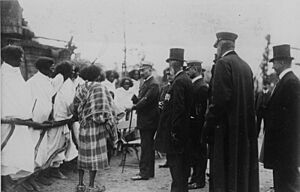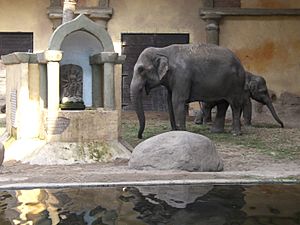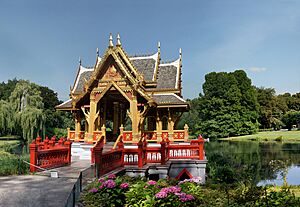Tierpark Hagenbeck facts for kids
 |
|

Zoo entrance by the tropical aquarium
|
|
| Date opened | 7 May 1907 |
|---|---|
| Location | Lokstedter Grenzstraße 2 22527 Hamburg, Germany |
| Land area | 25 ha (62 acres) |
| Coordinates | 53°35′47″N 9°56′16″E / 53.59639°N 9.93778°E |
| No. of animals | 14.300 |
| No. of species | 530 |
The Tierpark Hagenbeck is a famous zoo located in Stellingen, Hamburg, Germany. It started in 1863 with a collection of animals owned by Carl Hagenbeck Sr. He was a fishmonger who loved collecting animals. The zoo itself was officially opened in 1907 by his son, Carl Hagenbeck Jr.. This zoo is special because it was the first to use open areas for animals. These areas were surrounded by moats (water-filled ditches) instead of metal bars. This design helped the animals feel more like they were in their natural homes.
Contents
History of Hagenbeck's Animal Park
Early Animal Collections
In 1863, Carl Hagenbeck Sr. began collecting interesting animals. These animals arrived through Hamburg's busy port. By the 1870s, trading animals became more profitable than selling fish. Hagenbeck became one of Europe's top exotic animal traders. In 1874, his son, Carl Hagenbeck Jr., traveled the world to find new animals.
At first, Hagenbeck also showed people from different cultures. He wanted to show them living in their "natural" ways. For example, he displayed Samoan and Sámi people. The Sámi display included their tents, tools, and sleds, along with reindeer.

In 1874, Hagenbeck opened a facility in Hamburg called Carl Hagenbeck's Tierpark. He continued to show different cultures. In 1876, he started showing Nubians across Europe. He also sent someone to Labrador to bring some "Esquimaux" (Inuit) from Hebron. These Inuit were also shown at the Hamburg Tierpark.
Over time, these cultural shows became less popular. This was especially true as photography became more common. Hagenbeck's displays started to look less real compared to photos. After one show, Hagenbeck had many elephants left that no one wanted to buy. Since he could not sell them, he started a circus. To make his shows more exciting, Hagenbeck began making his animal displays more realistic. These new ideas later changed how animal zoos were designed.
Amazing Panorama Exhibits
In the 1890s, Hagenbeck created his first "panorama" exhibit. He even got a patent for his idea in 1896. This display was called the "Northern Panorama." In the front, there were seals and walruses swimming in a pool. A hidden moat was behind the pool, so visitors could not see it. Beyond this moat were reindeer. Then, behind a second hidden moat, were polar bears. By hiding the moats, it looked like all the animals were living together in one big landscape.
In 1907, Hagenbeck built a brand new zoo outside of Hamburg. He named it Tierpark Hagenbeck, and it is still in the same spot today. Hagenbeck wanted to design the whole zoo using his panorama system. He also wanted to show that animals from warm places did not need to live in expensive, humid buildings. Instead, he wanted his displays to look very real.
Hagenbeck used information from his circus to figure out how high and far different animals could jump. With this data, he built moats filled with water or empty pits. He made sure these moats were too wide or deep for the animals to cross. By using moats to separate animals that could not swim, visitors could look across a large part of the zoo. They could see many animals at once, just as if they were in the wild. Before Hagenbeck, zoos did not group animals by their species. Hagenbeck changed how zoos were laid out by grouping his animals together by species.
Hagenbeck's new design was a huge success. In 1911, he designed the Rome Zoo using the same style. In 1913, he created the first monkey-rock exhibit. This was an artificial rock with a 16-foot (4.9 m) moat around it. About 200 hamadryas baboons lived on this rock.
Hagenbeck called his design an animal paradise. He believed that "animals would live beside each other in harmony." He also thought that the "fight for survival would be eliminated" in his zoo.
World War I and II Impacts
Hagenbeck passed away in 1913. However, his zoo remained popular until big political events in Europe caused problems. During World War I, many of the zoo keepers were called to join the German army. The military also took horses from people to use in the war. So, many of Hagenbeck's animals were rented out to pull wagons. They helped deliver coal and wood to homes. It was common to see elephants and trained bears pulling heavy wagons.
After the war, Germany faced a deep economic depression. The zoo had to close for two years. Later, during the Bombing of Hamburg in World War II, the original zoo was destroyed. After the war ended, the zoo was rebuilt. Today, the Hagenbeck family still privately owns and runs the zoo.
Monkey Adventure
In July 1956, forty-five rhesus monkeys escaped from the zoo. They ran wild throughout Hamburg. People called for help when they found monkeys in their bedrooms and bathtubs! Some monkeys sat in trees, chattering excitedly. They showed each other toothpaste, soap bars, and other bathroom items they had taken. Zoo managers reported that police, firefighters, zoo keepers, and even schoolchildren helped catch more than two dozen of the long-tailed Indian monkeys.
Antje the Walrus
In 1976, the zoo got a female Pacific walrus. Hagenbeck named her Antje, after his sister. Antje became the famous logo for the north German television network NDR from 1983 to 1996. Antje died in 2003. She is now preserved and on display at the Zoological Museum of Hamburg.
Soon after, a children's cartoon called "Antje, Tiger und Bär" aired on German television. It featured a blue walrus character based on Antje. The character was designed by children's author Janosch. In 2013, Tierpark Hagenbeck welcomed a male and three female walruses from Moscow.
Sala Thai Pavilion
Inside the park, you can find the Sala Thai. Its full name is Sala Thai Chaloem Phra Kiat, which means "Thai pavilion of royal celebration." It is a traditional Thai pavilion. It was designed by Thai National Artist Pinyo Suwankiri.
The pavilion was built in Thailand over five months. Then, it was taken apart, shipped to Germany, and put back together. Twenty skilled craftsmen from Thailand reassembled it in less than two months. It is said to be the largest Thai pavilion of its kind in Europe. The Thai government gifted it in 2002. This gift celebrated the 72nd birthday of King Bhumibol. It also honored the good relationship between the two countries. Suwankiri designed the pavilion using old-fashioned joinery techniques. This means it was built without using a single nail!




